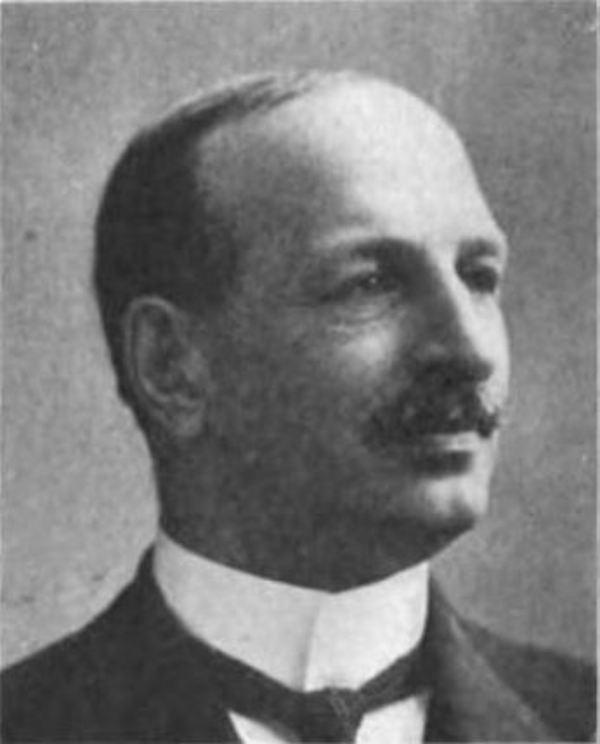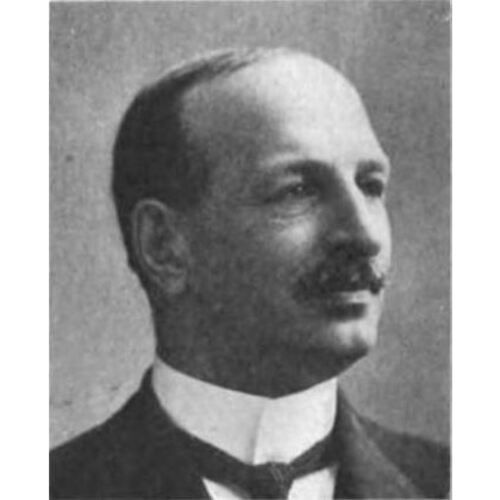
Source: Link
LAVOIE, NAPOLÉON (baptized Joseph-Eugène-Napoléon), athlete, banker, insurance broker, and office holder; b. 5 Aug. 1860 in Notre-Dame-de-Bon-Secours-de-L’Islet (L’Islet), Lower Canada, eldest son of Napoléon Lavoie, a physician, and Marie-Aurélie-Joséphine Casgrain; m. 17 Aug. 1880 Elmire Morin (d. 6 Feb. 1925) in the parish of Saint-Roch, Quebec City, and they had 13 children, of whom 4 boys and 3 girls reached adulthood; d. 24 May 1934 in that city and was buried there four days later in Saint-Charles cemetery.
Napoléon Lavoie, who came from families whose members belonged to the professional elite of the Côte-du-Sud region, broke from tradition and chose a career path that differed from those of his three brothers. Like his father, Arthur became a physician, while Joseph and Georges entered the priesthood. Young Napoléon possessed undeniable athletic skills that enabled him to excel at Canadian and international handball and squash competitions well into his later years. At the turn of the 20th century he would even hold the title of Canadian handball champion.
After a few years of instruction with the Brothers of the Christian Schools in Notre-Dame-de-Bon-Secours-de-L’Islet and at the Collège de Sainte-Anne-de-la-Pocatière (1873–75), at approximately age 15 Lavoie began working as a junior clerk at the Banque Nationale, probably in Quebec City. From about 1885 he pursued his career at the Saint-Roch branch of the Banque du Peuple. He became branch manager around 1890 and held that post until the bank was forced into liquidation in 1895 [see Jacques Grenier*]. He then returned to the Banque Nationale as manager of the Saint-Roch branch, which was located near the place where the Banque du Peuple had stood prior to its closure.
Around 1901 Lavoie took over the position of inspector of the Banque Nationale and, beginning in 1910, that of general manager. He was in charge of a network of branches that he helped develop in the province’s regions; he also opened the institution’s first branch in France in 1907. While carrying out his duties, he clashed with the Caisses Populaires Desjardins and its founder, Alphonse Desjardins*, who were seeking opportunities in the same territory. The confrontation took a nasty turn when Lavoie let rumours spread regarding the instability of the caisses, and wherever they wanted to or could open a branch, he created sub-branches to collect deposits. In a letter written on 21 Oct. 1914 Desjardins did not mince words, describing Lavoie as a “loathsome individual … a conceited person puffed up with pride and as thick as a brick.”
Nonetheless, Lavoie achieved a fair degree of success with these strategies, whose objectives were to avoid missing out on deposits in francophone communities and to sustain the growth of the Banque Nationale. If his methods left him exposed to criticism by the caisses populaires, which argued that the bank’s sub-branches took local savings without reinvesting them where they were generated, he could reply that his competitors did not do much better. Moreover, the caisses were required to deposit their surplus funds in banks, which gave the Banque Nationale an additional means of making life difficult for them. It is not certain whether the Banque Nationale had played a role, either directly or through the intervention of the Caisse d’Économie de Notre-Dame-de-Québec (with which it had had ties since the bank’s establishment), in offering a less favourable rate of interest on the deposits of the caisses populaires than on those of other banks. This was, nevertheless, the perception shared by the directors of the caisses, who entrusted their investments to the Quebec Bank in 1914.
To achieve concrete gains from its increased deposits, the Banque Nationale had to find investments that would be profitable but safe enough to guard against changing economic conditions. Under Lavoie’s direction, it devoted a sizeable part of its funds to financing a few large, but fragile and speculative, companies, in particular Charles-Abraham Paquet’s Compagnie Manufacturière de Montmagny (which in 1919 became National Farming Machinery Limited) and the Transportation and Shipping Company Limited in Quebec City. The rate of return was high, but in 1921 the ongoing economic crisis in the agricultural sector prompted numerous withdrawals of deposits, to the detriment of National Farming Machinery Limited, which owed between $3.8 and $4.5 million to the Banque Nationale. For its part, the Transportation and Shipping Company Limited had a debt that amounted to $1.25 million. Lavoie was at the centre of the upheaval. He was faced with a devaluation of the bank’s assets and the threat of a run by its depositors. He succeeded in getting help from the federal government, but the amount was not large enough to re-establish the bank’s credit, and thus in 1922 a merger with another financial institution had to be considered. Leading politicians, such as Quebec premier Louis-Alexandre Taschereau* and federal justice minister Sir Lomer Gouin*, as well as businessmen from Quebec City, led by Georges-Élie Amyot* of the Dominion Corset Company and the new president of the bank, attempted a rescue. Henri Des Rivières, Taschereau’s nephew, replaced Lavoie in the position of general manager of the Banque Nationale and on its board of directors in March. The Banque Nationale merged with the Banque d’Hochelaga to form the Banque Canadienne Nationale in 1925.
This abrupt end to his banking career plunged Lavoie into serious financial and professional difficulty. He had to liquidate a property he had inherited in the Limoilou district, transfer to another party a claim he held with his brother Arthur, borrow $5,000 from businessman Napoléon Drouin, and finally, in 1926, sell his beautiful house on Rue Saint-Louis, which he had bought with a large mortgage from the Société de Prêts et de Placements de Québec in 1918. He took a new direction and worked for a while as an insurance broker with his sons Georges and Napoléon (the latter had also been employed by the Banque Nationale). In 1928 he held a position as an income-tax inspector, which gave him the means to remain on Rue Saint-Louis, where he lived with his daughter Marie-Joséphine until his death in 1934 following a long illness.
Napoléon Lavoie’s competitive spirit, both in sports and in the banking business, enabled him to rise to the top during his career. But it also caused him to take great risks with the investments of the Banque Nationale, which resulted in serious consequences for the bank and for himself.
Arch. de la Fédération des Caisses Desjardins du Québec (Lévis, Québec), Fonds Alphonse-Desjardins, 0.21: 2.1–10.5 (lettre d’Alphonse Desjardins à J.‑Victor Rochette, 21 oct. 1914). BANQ-Q, CE301-S22, 17 août 1880; CE302-S3, 5 août 1860. FD, Cimetière Saint-Charles (Québec), 9 févr. 1925, 28 mai 1934. Québec, Ministère de l’Énergie et des Ressources Naturelles, “Registre foncier du Québec en ligne,” acte, radiation, avis d’adresse, Québec, acte, nos.164294rb, 164295rb, 183345rb, 183346rb, 184624rb, 187819rb, 196147rb, 200556rb: www.registrefoncier.gouv.qc.ca/Sirf (consulted 10 March 2016). L’Action catholique (Québec), 25, 29 mai 1934. Le Devoir, 25 mai 1934. Le Soleil, 25, 28 mai 1934. BCF, 1920: 81. Directory, Quebec City, 1918–19, 1935–36. J.‑A. Lavoie, La famille Lavoie au Canada, de 1650 à 1921 (Québec, 1922). Prominent people of the province of Quebec, 1923–24 (Montreal, n.d.). Yves Roby, Alphonse Desjardins et les caisses populaires, 1854–1920 (Montréal, 1964). Ronald Rudin, Banking en français: the French banks of Quebec, 1835–1925 (Toronto, 1985); In whose interest? Quebec’s caisses populaires, 1900–1945 (Montreal and Kingston, Ont., 1990).
Cite This Article
Marc Vallières, “LAVOIE, NAPOLÉON (baptized Joseph-Eugène-Napoléon),” in Dictionary of Canadian Biography, vol. 16, University of Toronto/Université Laval, 2003–, accessed December 30, 2025, https://www.biographi.ca/en/bio/lavoie_napoleon_16E.html.
The citation above shows the format for footnotes and endnotes according to the Chicago manual of style (16th edition). Information to be used in other citation formats:
| Permalink: | https://www.biographi.ca/en/bio/lavoie_napoleon_16E.html |
| Author of Article: | Marc Vallières |
| Title of Article: | LAVOIE, NAPOLÉON (baptized Joseph-Eugène-Napoléon) |
| Publication Name: | Dictionary of Canadian Biography, vol. 16 |
| Publisher: | University of Toronto/Université Laval |
| Year of publication: | 2020 |
| Year of revision: | 2020 |
| Access Date: | December 30, 2025 |



